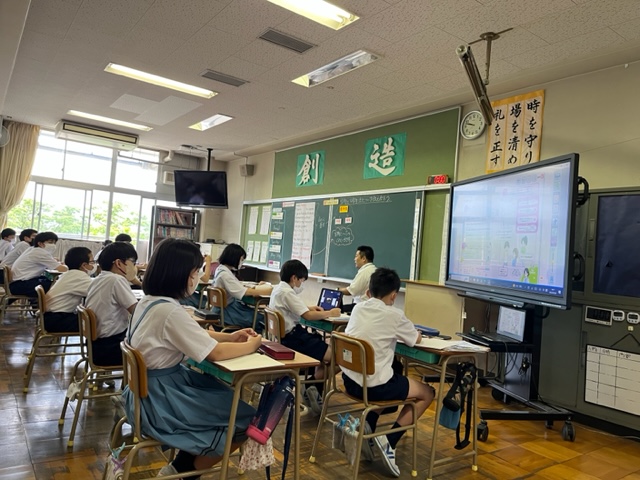
letters-home-school-life-in-japan
A regular reader of my column wrote to ask about school life in Japan. When she wrote to me, children all over the U.S. were getting prepared to go back to school in late August, and seeing all the “back to school” displays and commercials on TV, she was wondering about the school system in Japan.
Thanks to her question, this is the topic of this week’s column. Thank you, Linda, for the question!
The school year in Japan begins in April and the first semester ends in late July or early August. The second term begins in September and continues through February with graduation always happening in March.
Elementary schools often have a trimester system, where they study from April until July, then September through December, and finally January through March. Most elementary schools have about a 40-day summer vacation each year.
Normally, students are expected to be at school by about 8:30 a.m. and the school day ends around 3 p.m. However, most students belong to after-school clubs so these activities begin when classes finish and can continue up through the early evening.
Then, many students go on to a private cram school where they will often study until 9 p.m. These cram schools focus on offering supplemental lessons that are related to the courses the students take at their regular schools. These can include English, science, math, etc. In elementary schools, extracurricular activities are usually allowed from grade four during school hours and these are called tokubetsu katsudo (special activities).
Since students sometimes have to take an entrance exam to get into a higher-level school, parents view “cram schools” as good value for the money if the student is able to get into a preferred school upon graduating from elementary, junior high, or senior high school.
Typically, students attend school for twelve years of formal education, which include elementary, lower, and upper secondary schools. Even though students are six years old when they begin schooling, most children attend preschools or kindergartens from the ages of 3 to 5 years old. Compulsory education lasts for nine years (through middle school), but most students continue onto high school.
One interesting difference in how Japanese secondary schools operate is that students have a classroom where they stay the entire day, and teachers come to the classroom to teach their lessons. These are called “homerooms” and students do not change classrooms except for laboratory-related classes or physical education. They have assigned desks and they remain in the classroom for the entire day where the lecture-type of classes are taught. Classes on average have 40 students assigned to each homeroom.
Because the university where I teach has only an education faculty, all of my students enroll to become future teachers. In Japan, being a teacher is revered and held in high regard, and it is still considered to be an esteemed honor to be a teacher, so salaries remain quite good and competitive, making education a popular profession to choose for students entering university. In addition, because my university is a national university, we have a number of attached elementary and junior high schools that we oversee, so I have many opportunities each year to visit the attached schools to observe my students practice teaching, or to visit lessons to observe how teachers conduct their lessons.
Japanese students normally have daily homework they are expected to do before the next day. The photo of three elementary school students (photo above) is one I took on a train on a Friday evening about 6:30 p.m. I suspect they are all siblings, because the older girl kept poking the boy to her left to wake him up — each time admonishing him for not working on his homework.
The poor kid was so tired he couldn’t keep his eyes open, and reacted like any little brother would to a sister trying to boss him! He would swat at her and tell her to stop. Monday was scheduled as a holiday and I have a feeling they were going somewhere for the weekend with their parents so that is why they were trying to get their homework completed before arriving home, in order not to have to do it during the long weekend.
The idea behind daily homework assignments for elementary-aged students is to foster in them early on good study habits at home which will serve them well once they get to junior high and then senior high school. The homework is largely comprised of preparation and review tasks (busy work), with the content depending upon the subject. Also, students are given an extensive summer homework task to do during their vacation. This could include reading books and writing book reports, or growing a plant like tomatoes, and keeping a daily journal about the progress, or maybe doing some sort of art project, like a painting, over the summer.
A few years ago, my neighbor boy and his mother visited me unexpectedly because as his summer homework, he was supposed to interview a native-English speaker. Lucky for him, he had one in the condo next door!
So, I invited them in and he asked me several questions about my life in Japan. His classmates likely had to stop a stranger on the street to get their interview completed, which has happened to me before, when out and about or taking a train.
Todd Jay Leonard grew up in Shelbyville, but has lived and worked in Japan for over 30 years. He is a university professor, teaching courses in history, cross-cultural understanding, and English in the Faculty of Education, for both the undergraduate and graduate programs at the University of Teacher Education Fukuoka (UTEF). Professor Leonard is the author of 26 books, and calls Munakata-shi, Fukuoka-ken, home, where he lives, writes and teaches. He can be contacted at toddjayleonard@yahoo.com.





